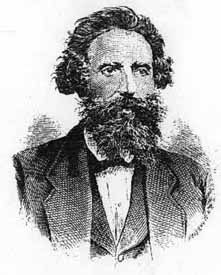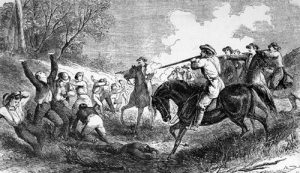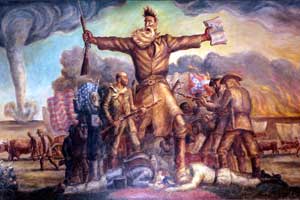The first raid by the Missourians into Linn County, Kansas, was made in the fall of 1856. The party was headed by the notorious George Washington Clarke and consisted of about 400 men. This party went to the old town of Paris, a pro-slavery settlement. There, they were joined by other Confederates, among whom was the almost equally notorious James P. Fox. From Paris, the party went to Sugar Mound, where they burned down several houses and robbed Ebenezer Barnes’ house, store, and post office. Many depredations were committed, and several Free-State families started back to the East, including William Hobson’s and Ebenezer Barnes’ families, to Illinois.
Mr. Barnes himself remained. Colonel James Montgomery was at Sugar Mound then and was also an object of desire to the Missourians, but he managed to escape, and the border ruffians thought he had started for home. Instead, Montgomery went to Missouri to learn who composed Clarke’s band.
However, by the time he arrived, he was ill and went to the house of Captain Burnett and sought admittance. He was taken in and cared for by Mrs. Burnett; Captain Burnett not being at home. Some time afterward, Mr. Burnett, who was out with Clarke on a raid, returned and found Montgomery, whom he did not know, at his house. Montgomery told him he was on his way from New York to Kansas and desirous of finding a school to teach during the winter. Soon, Burnett found him a school, which he taught for about two weeks, during which time he learned all he desired to know as to the identity of Clarke’s raiders. He then returned to Kansas, where he formed a company of seven men to go into Missouri and bring back the property stolen by Clarke’s band or its equivalent. Upon arriving in the neighborhood of the Burnetts, the men hid in the woods. The Miami Indians were then still living on their Kansas reservation and were in the habit of going to Missouri to steal horses. The Missourians, also in the neighborhood of Burnetts, upon discovering the presence of Indians in the vicinity, were accustomed to reporting the fact to Burnett. Montgomery, having his party in the timber, disguised two of themselves as Indians, mounted them on one horse, and sent them around throughout the neighborhood to create the impression that Indians had come and to cause all who should see them to report to Burnett. His two “Indians” having returned, Montgomery, with all his men, moved forward and took possession of Burnett’s house when Burnett was away.

Colonel James Montgomery
Soon, the neighbors came in on horseback one at a time. As each approached, one of Montgomery’s men would go out to meet him, disarm him, take his horse, and lead him into the house as a prisoner. In this way, 21 prisoners were captured. Burnett himself was similarly secured. Montgomery’s men then broke the guns of their prisoners, took $250 in money, selected 11 good horses, and returned to Little Sugar Creek In Kansas. Upon arriving at Sugar Mound, Montgomery, leaving his men with the horses in the timber, went to the house of Ebenezer Barnes to prepare supper for himself and his men. Still, Mr. Barnes’ family had not returned, and there was nothing to eat in the house. He then went to Judge Cannon’s house, but the Judge, although a Free-State man for Kansas Montgomery, had done and did not desire to be identified with him in such operations. Eventually, most of the settlers returned. Some of their cabins had been burned, and a large amount of property had been carried away or destroyed. Judge Cannon found his cabin and its contents as he had left them, while Isaac Dement found his two little cabins burned down, but his household goods had been previously removed and remained piled up on the ground.
Colonel James Montgomery soon became one of the most powerful friends of the Free-State men and the most hated and feared by the pro-slavery men. Though his operations were classed as defensive, preventive, and retaliatory, it is undoubtedly true that he did many things that would not stand the test of the moral code. With six men, he attacked Briscoe Davis, a pro-slavery man and captain of a company of Territorial Militia, with the view of making Davis prisoner and securing the company’s arms.
Davis, however, was not at home, and all that was secured at his house was one prisoner, several arms, and some ammunition. While Montgomery was engaged in secreting the arms, the prisoner made his escape. On this account, Montgomery abandoned his design of attacking and disarming the pro-slavery men on Big Sugar Creek and, to avoid the Territorial Militia, which was in force under Governor John Geary, eight miles south, on Little Sugar Creek, made a wide detour south into Bourbon County, coming in sight of some Texas Rangers immediately fled to Fort Scott Montgomery’s men, that the inhabitants of the town deserted it in a panic.
In the fall of 1858, Old John Brown appeared on the Linn County scene. He had been invited into the county by Augustus Wattles to assist in fighting the pro-slavery men. Wattles, who had formerly lived in Douglas County, Brown to his friends and others as “Subel Morgan,” and it was by that name that Brown was generally known while operating against slaveholders and other pro-slavery men, with Linn County as his base of operations. Only a few of his immediate friends knew that it was actually John Brown. His personal safety required that he conceal his identity and, frequently, his whereabouts. While in Linn County, Brown stayed at Wattles’ house, working through the end of the year freeing slaves. His determined opposition to the incursions into Kansas of the Missourians and his own determined incursions into Missouri awakened the bitterest hostility against him. The Governor of Kansas offered a reward of $3,000 for his arrest, and President James Buchanan offered a reward of $250 for his head. When Brown heard of the President’s offer, he retorted by saying that, although he did not consider Buchanan’s body worth $2.50, yet he would give that sum to anyone who would deliver it to him. He also said that he would offer a like sum for the head of Governor Samuel Medary but that he feared some of his men would earn the reward.

Bleeding Kansas era.
On December 20th, Brown’s men in two parties, one under his own command and the other under the command of J. K. Kagi, went into Missouri to liberate slaves. Brown’s party liberated ten slaves, and Kagi’s party liberated one slave and killed the owner, a German, who could neither understand nor speak English. This murder caused intense excitement throughout the country and was the immediate occasion for offering the above-mentioned rewards. The liberated slaves were taken into Franklin County and secreted in an old cabin about four miles southwest of Lane for a month. At the end of the month, Brown went north with the freed slaves, and when near Holton, an attempt was made by some pro-slavery men from Atchison to rescue them. But their attempt failed, and the men retreated in what was called the “The Battle of the Spurs.”
The Marais des Cygnes Massacre occurred on the May 19, 1858. It was one of the most deliberate, inexcusable, and atrocious massacres recorded in the annals of history. While the people of Linn County were quietly planting corn and unsuspicious of danger, a band of 30 Missourians, under the command of Captain Charles A. Hamilton, about 8 o’clock in the morning, one mile below Choteau Trading Post, captured Patrick Ross, who was going from the Post to his farm nearby. Upon arriving at the Post with their prisoner, Captain Hamelton’s party arrested John F. Campbell, a storekeeper there, and two or three others, who were released. Elder B.L. Reed was captured one-half mile north of the Post while standing in the road talking about taking the school. At the same time and place, William A. Stilwell, who was on his way from Mound City to Kansas City in his wagon, was taken. Upon driving up, Hamilton asked him if he knew Montgomery, to which Stilwell replied that he had seen him but was not acquainted with him. Hamilton then commanded, “Get out and march in here.” Stilwell got out of his wagon and took his position with the other prisoners, leaving his team on the road. Some other persons were then taken and released. This occurred near Mr. Nichol’s house, which was searched for arms, and Mr. Nichol himself, but he was absent.

Massacre of Marais des Cygnes, Kansas.
Three or four of Hamilton’s men were next sent to bring in Asa Hairgrove, and another party was sent after Austin and Amos Hall, the main body marching toward Hairgrove’s house, about two miles from the Post. Amos Hall, who was nearly blind, and Asa Hairgrove were brought in. At the same time, William Colpetzer was captured. They then went in a northwesterly direction and brought in M. Robinson and Asa Snyder, who had a short time previously arrived from Illinois. Captain Hamelton, with seven men, started to arrest Captain Eli Snyder, the blacksmith, and bring him in, the main group proceeding on about a half mile to the top of Priestly Mound, from which elevated position the whole country for miles around could be overlooked. The latter party watched with considerable interest the attempt to arrest Captain Snyder, which, because of his courage and quickness in handling his musket, resulted in failure and some of Captain Hamelton’s men being severely wounded. Returning to the main body, Hamelton ordered a forward march. The prisoners were led down to a gulch, single file, when the commands were given, “Halt, front face, close up,” to the prisoners; and his own men were formed in line in front of them on a rock shelf about as wide as a good wagon road and somewhat higher than the prisoners’ heads. Deliberately the orders were given by Captain Hamelton, “Make ready, take aim,” but before the order “Fire” could be uttered, one of the worst of the border ruffians, a man named Brockett by name, turned his horse away, at which point Hamelton said to him, “Brockett, G–d d—n you, why don’t you wheel into line?” Brockett said, “I’ll be d—d if I’ll have anything to do with such a G—d piece of business as this. If it was in a fight I’d fire.” At this, Hamelton took out his revolver and fired at the prisoners, giving the order to his men to fire simultaneously. Alvin Hamilton’s gun, aimed at L.B. Reed, missed fire the first time; Reed, not being hit, turned partly around to see his companions fall, and Hamelton’s gun being immediately re-cocked and fired, received the ball on one of his ribs and fell. Thus, all these innocent, brave men were brought down. On their part, there was no flinching nor begging for a quarter. Just before the order to fire was given, Hairgrove said: “Gentlemen, if you are going to shoot us, take good aim.”

Border Ruffians in Kansas by F.O.C. Darley
After waiting a few minutes, Hamelton gave the order to his men to go down and see who was dead and to shoot those who were not. Two of the ruffians went down among the fallen and fired three shots at different ones who gave signs of life. Amos Hall was shot through the mouth. One said “Old Reed ain’t dead yet,” and a shot was fired when the remark was repeated, “Old Reed ain’t dead.” “Which is him?” was asked. “Why, there the old devil is, looking at you.” But Pat Ross got was killed instead. Another ruffian said, “See that man humped up, he ain’t dead.” The man “humped up” was Austin Hall, and his body was perfectly rigid. One of those finishing the butchery kicked Hall, rolled him over, and remarked, “He’s as dead as the Devil,” so let him alone. However, Hall was actually the only one not hit. Hamilton and his men then rode away in squads, six or seven at first, then twelve, and soon after the balance, leaving their victims all for dead. The shooting resulted in five being killed, five wounded and one unharmed. The killed were John F. Campbell, William Colpetzer, Patrick Ross, William Stilwell, and M. Robinson; the wounded Amos Hall, William Hairgrove, Asa Hairgrove, B. L. Reed, and Asa Snyder. The body of William Stilwell was taken to Mound City for burial. Those of the others were all buried in one grave, some distance south of the massacre scene. The wounded all recovered.
Captain Hamilton had prepared a list of from 60 to 70 Free-State men whom he had proscribed, and this massacre was the first of a contemplated series of massacres that was to be continued until the whole list had been slain. Happily, it chanced to be the last as well as the first. Montgomery was advised of the general plan and had been furnished with a list of the proscribed men. He determined to kill Hamelton at the first opportunity. To this end, about the first of May, he approached Hamelton’s log house with a party of men to capture him; but finding he could effect nothing in the way of an attack with rifles alone, he sent a squad of men to bring the howitzer. But before its arrival, a body of United States troops, on their way to Leavenworth, were called to Hamelton’s relief, and Montgomery was obliged to disperse his men. Montgomery then went to the Sheriff of Linn County, acquainted him with Hamelton’s designs, showed him the list of the proscribed Free-State men, and received assurances from the sheriff that the men would be protected from all harm.
Montgomery, who had been away at the time of the massacre, returned that evening. The next evening a force of about 200 citizens, under Sheriff McDaniel, Colonel. R B. Mitchell and Montgomery approached West Point, Missouri, to which place it was believed the murderers had fled. Before entering the town, a consultation was held, at which it was decided to send forward a small group to have a conference. In the meantime, several men were seen leaving town, and Montgomery and his men gave chase, captured one prisoner against whom nothing could be proved, and so released him. When they finally came out to the conference, the citizens deplored the massacre, denied all knowledge of the whereabouts of the murderers, and refused to aid in their apprehension.
During the summer, one of the murderers, Charles Matlock, was arrested, but while in Paris, Kansas awaiting his trial, he escaped from the guard and was never re-captured. Another of Hamelton’s men, William Griffith, was arrested in Platte County, Missouri, in 1863 and taken to Mound City for trial on an indictment for murder in the first degree. Griffith pled “not guilty” and set up as a defense the “Amnesty act,” approved February 11, 1859, alleging that the murder grew out of “political differences of opinion.” The jury, however, not satisfied with the plea as a defense, found him guilty. William Griffith was hanged on October 30, 1863. William Hairgrove, one of the massacre’s survivors, was the executioner.
Compiled by Kathy Weiser/Legends of Kansas, updated January 2023.
Also See:


